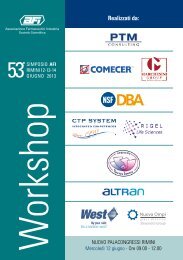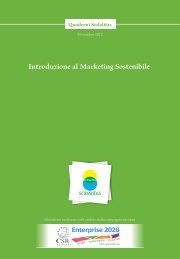NEWS - Altran
NEWS - Altran
NEWS - Altran
Create successful ePaper yourself
Turn your PDF publications into a flip-book with our unique Google optimized e-Paper software.
news<br />
altran CommuniCAtion<br />
Altitude ’s<br />
wearing green<br />
<strong>Altran</strong>’s science and technology magazine has<br />
existed in its current form for almost five years,<br />
and its first 12 issues were printed on<br />
environmentally friendly offset paper.<br />
Altitude is refreshing its feel for this 13th<br />
publication in honour of its theme.<br />
Our paper and printing will now be PEFC<br />
certified. This is an eco-label dedicated to<br />
sustainable forest management.<br />
The logo, affixed on a wood or wood-based<br />
product, guarantees that the product is made of<br />
wood from sustainably managed forests that are<br />
PEFC (Program for the Endorsement of Forest<br />
Certification schemes) certified for the entire<br />
printing process—from the forest to the printer.<br />
More information at www.pefc.org<br />
GreenHouse eFFeCt<br />
australia ratifies<br />
the Kyoto protocol<br />
The Australian Prime<br />
Minister Kevin Rudd’s<br />
first act of office was to<br />
ratify the Kyoto Protocol<br />
on December 3, 2007. Up<br />
until then, Australia and<br />
the United States were<br />
the only two industrialised<br />
countries that hadn’t yet<br />
ratified the protocol. In<br />
signing the agreement,<br />
Australia commits, during<br />
the phase running from<br />
2008 to 2012, to reducing<br />
DR<br />
greenhouse gas emissions<br />
by 5.2% in comparison to<br />
levels recorded in 1990.<br />
According to data submitted<br />
to the secretariat of the<br />
United Nations Framework<br />
Convention on Climate<br />
Change (UNFCCC) by the<br />
signatories, the 40 most<br />
industrialised countries<br />
once again increased their<br />
greenhouse gas emissions<br />
(GGE) in 2005. On the<br />
decline from 1990 to 2000,<br />
altran trAnsportAtion<br />
an electricity miracle in Jerusalem<br />
Cities increasingly<br />
constitute the front line<br />
of defence in protecting<br />
the environment, but<br />
not merely through<br />
mitigating measures<br />
taken only when<br />
pollution reaches<br />
alarming levels. In<br />
an effort to decrease the environmental impact of public<br />
transportation and to encourage residents to leave their cars at<br />
home, the municipality of Jerusalem has invested in a tramway<br />
network, a means of electric transport that reduces CO 2<br />
emissions.<br />
To reduce its traffic congestion, the Sacred City has turned to<br />
Alstom, for whom <strong>Altran</strong> implements traffic and security systems.<br />
This solution has allowed the city to reduce atmospheric and<br />
sound pollution, and <strong>Altran</strong> will be doing the same for Algiers’<br />
metro system, in a city famous for its overburdened streets.<br />
the emissions began<br />
rising again between 2000<br />
and 2005. Greenhouse<br />
gas emissions reached<br />
18.2 billion tons in 2005,<br />
compared to 17.7 billion<br />
in 2000. Australia alone<br />
experienced a rise of almost<br />
26% in emissions between<br />
1990 and 2005.<br />
GraphicObsession<br />
altran Anti-wAste<br />
small drops maKe<br />
an ocean<br />
The employees of the EILiS (Energy,<br />
Industry and Life Sciences) perimeter<br />
at <strong>Altran</strong>’s headquarters are, naturally,<br />
receptive to sustainable development<br />
and have decided to lead the effort<br />
through a campaign of humorous<br />
posters urging everyone to help out<br />
by reducing motor transport, energy<br />
consumption and paper waste, thanks<br />
to a few easy tricks and fun facts and<br />
figures. An initiative to copy… front<br />
and back!<br />
number<br />
3,500<br />
trees planted<br />
part of altran’s 2008<br />
resolutions is to actively<br />
support the flagship initiative<br />
of united nations<br />
environment programme<br />
(unep): plant for the planet.<br />
in teaming up with the green<br />
Belt movement, altran has<br />
planted 3,500 trees so far.<br />
For more information:<br />
www.greenbeltmovement.org<br />
In Nature magazine, Valier Galy and Christian<br />
France-Lanord from the Petrographic and<br />
Geographic Research Centre in Nancy (CNRS-<br />
INSU) explain that the Himalayas contribute to<br />
reducing the amount of carbon in the earth’s<br />
atmosphere over a very long period of time<br />
(millions of years). The erosion of mountains<br />
such as the Himalayas causes huge quantities of<br />
organic matter to be transported to the ocean.<br />
During photosynthesis, atmospheric CO 2 helps<br />
produce organic molecules, which mostly take<br />
plant form. This organic matter oxidises in the<br />
soil, returning to the atmosphere in the form of<br />
CO 2 . However, some of it is swept to the ocean,<br />
and then buried in sediment at the bottom. Over<br />
time, this process of burying organic carbon<br />
captures CO 2 from the atmosphere. The study<br />
shows that in the Himalayas, three-fourths of<br />
new organic material is transported and buried<br />
in sediments deposited in the Bay of Bengal.<br />
Since CO 2 is a greenhouse gas,<br />
this CO 2 “capture” in the Himalayas can<br />
contribute to climate cooling.<br />
04 Altitude n°13 / april 2008 Altitude n°13 /april 2008 05<br />
© Clément Perrotte<br />
DR<br />
CLimAte<br />
are the himalayas<br />
cooling the climate?








